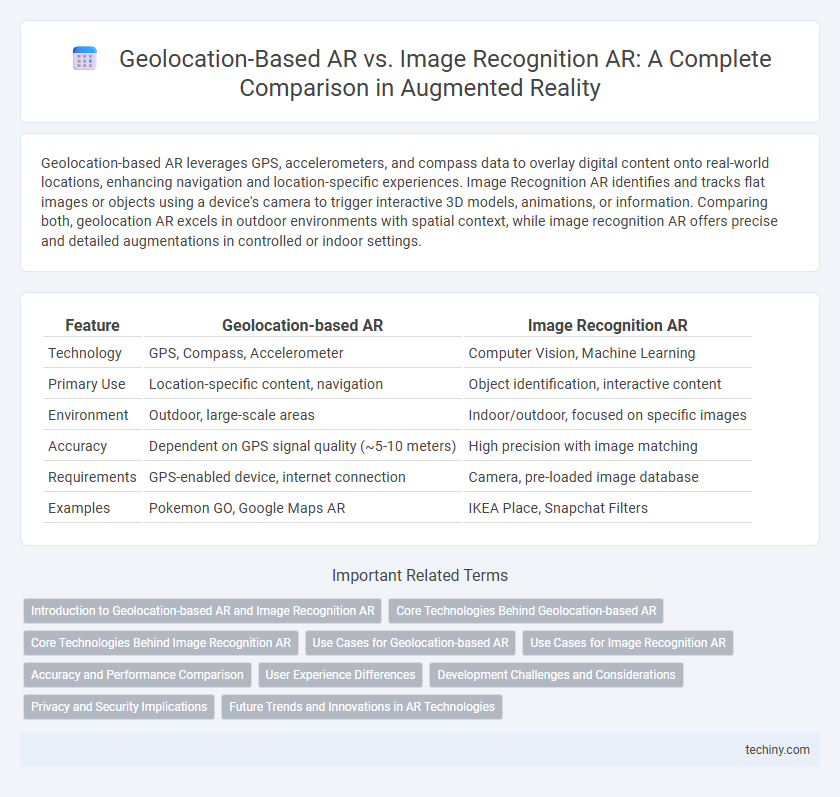Geolocation-based AR leverages GPS, accelerometers, and compass data to overlay digital content onto real-world locations, enhancing navigation and location-specific experiences. Image Recognition AR identifies and tracks flat images or objects using a device's camera to trigger interactive 3D models, animations, or information. Comparing both, geolocation AR excels in outdoor environments with spatial context, while image recognition AR offers precise and detailed augmentations in controlled or indoor settings.
Table of Comparison
| Feature | Geolocation-based AR | Image Recognition AR |
|---|---|---|
| Technology | GPS, Compass, Accelerometer | Computer Vision, Machine Learning |
| Primary Use | Location-specific content, navigation | Object identification, interactive content |
| Environment | Outdoor, large-scale areas | Indoor/outdoor, focused on specific images |
| Accuracy | Dependent on GPS signal quality (~5-10 meters) | High precision with image matching |
| Requirements | GPS-enabled device, internet connection | Camera, pre-loaded image database |
| Examples | Pokemon GO, Google Maps AR | IKEA Place, Snapchat Filters |
Introduction to Geolocation-based AR and Image Recognition AR
Geolocation-based AR leverages GPS, accelerometers, and digital compass data to overlay digital content onto physical locations, enabling immersive experiences tied to real-world coordinates. Image Recognition AR uses computer vision to identify and track visual markers or objects in the environment, triggering relevant digital interactions based on recognized images. Both technologies enhance user engagement by integrating virtual elements seamlessly with actual surroundings, but differ fundamentally in their reliance on positional data versus visual markers.
Core Technologies Behind Geolocation-based AR
Geolocation-based AR leverages GPS, accelerometers, and digital compass sensors to precisely determine a user's location and orientation in real-time, enabling context-aware augmented experiences. Advanced mapping algorithms and spatial data integration allow seamless overlay of digital content onto physical environments based on geographic coordinates. This technology contrasts with image recognition AR, which relies primarily on computer vision and pattern recognition techniques to detect and augment specific visual markers or images.
Core Technologies Behind Image Recognition AR
Image Recognition AR relies on computer vision algorithms and machine learning models to identify and track visual markers or objects in real time, enabling precise overlay of digital content. Core technologies include convolutional neural networks (CNNs) for feature extraction, pattern recognition techniques, and real-time processing frameworks like OpenCV or ARKit that facilitate accurate detection and tracking. These components work together to enable robust and context-aware augmented reality experiences by interpreting visual input from the device's camera.
Use Cases for Geolocation-based AR
Geolocation-based AR leverages GPS, accelerometer, and compass data to overlay digital content on real-world locations, making it ideal for navigation, tourism, and outdoor gaming applications. Popular use cases include interactive city guides, location-based marketing campaigns, and augmented reality scavenger hunts that enhance user engagement in physical spaces. This technology excels in delivering context-aware experiences by mapping virtual elements precisely to specific geographic coordinates.
Use Cases for Image Recognition AR
Image Recognition AR excels in retail environments by enabling customers to scan products for detailed information, reviews, and virtual try-ons, enhancing the shopping experience. Museums and educational institutions benefit from this technology by overlaying interactive content on exhibits, providing users with immersive learning opportunities. Marketing campaigns leverage Image Recognition AR to create engaging advertisements that users can interact with by scanning posters or packaging, driving higher engagement and brand recall.
Accuracy and Performance Comparison
Geolocation-based AR leverages GPS, accelerometer, and compass data to overlay digital content based on real-world coordinates, offering broad outdoor experiences but often facing accuracy issues due to signal interference and environmental factors. Image Recognition AR relies on computer vision technology to detect and track predefined images or objects, providing highly precise alignment and stable performance indoors with consistent lighting conditions. While geolocation AR excels in scale and dynamic environment adaptability, image recognition AR outperforms in accuracy and real-time responsiveness for fixed, small-scale applications.
User Experience Differences
Geolocation-based AR offers immersive experiences by overlaying digital content onto real-world locations using GPS and compass data, enabling users to explore environments interactively. Image Recognition AR relies on identifying specific visual markers or objects, providing precise and context-aware augmentations tied to scanned images or surfaces. The user experience in geolocation AR is expansive and dynamic but can be less accurate outdoors, while image recognition AR delivers high accuracy and detail in controlled settings, enhancing engagement with specific physical items.
Development Challenges and Considerations
Geolocation-based AR requires precise GPS integration and real-time mapping to maintain accurate virtual overlays, posing challenges in environments with poor satellite signals or dense urban areas. Image Recognition AR depends on high-quality image processing and machine learning algorithms to identify and track objects, demanding substantial computational power and extensive training data. Developers must consider latency, hardware constraints, and environmental variability when optimizing both AR types for seamless user experiences.
Privacy and Security Implications
Geolocation-based AR relies on GPS data to provide location-specific experiences, raising concerns about real-time tracking vulnerabilities and unauthorized data sharing, which can compromise user privacy. Image Recognition AR processes visual inputs through cameras, potentially exposing sensitive personal environments and biometric data to third-party access or cyberattacks. Ensuring robust encryption, anonymization protocols, and stringent access controls is crucial to mitigating security risks in both AR modalities.
Future Trends and Innovations in AR Technologies
Geolocation-based AR is expected to advance with enhanced GPS accuracy and integration of 5G networks, enabling more precise and immersive location-specific experiences. Image Recognition AR will benefit from breakthroughs in AI-powered computer vision and real-time object tracking, facilitating seamless interaction with physical environments. Future trends point towards hybrid AR systems combining geolocation data and image recognition for richer, context-aware applications in industries like retail, tourism, and urban planning.
Geolocation-based AR vs Image Recognition AR Infographic

 techiny.com
techiny.com